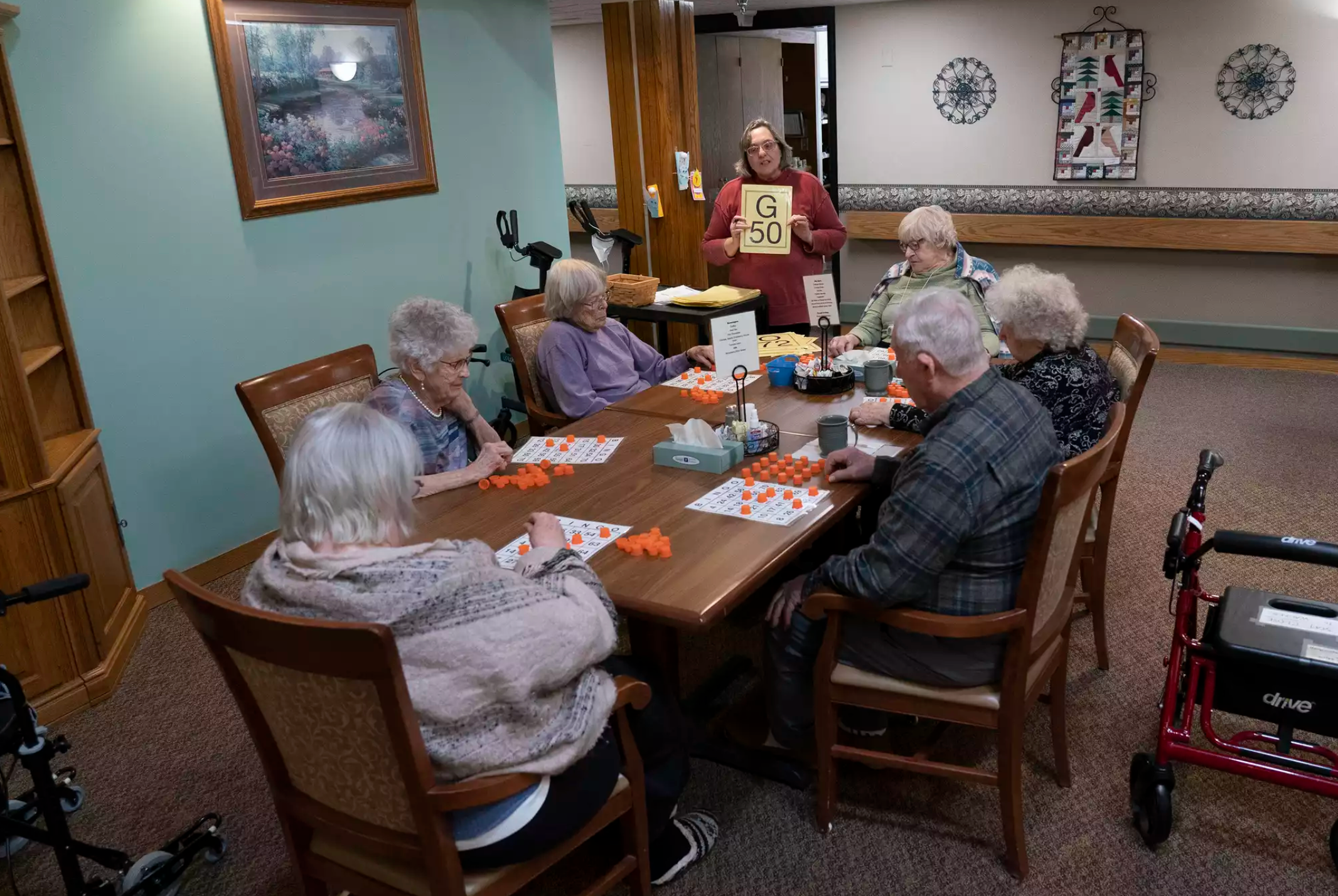‘It’s a struggle right now’: Nursing homes press Minnesota lawmakers for help
Published 6:27 am Thursday, April 13, 2023

- Residents play B-I-N-G-O at Northfield Retirement Community on a recent afternoon. The facility experienced challenges during the COVID pandemic, losing a lot of their staff. The campus offers independent living, assisted living, skilled nursing care, and memory care. Nursing home owners around the state are urgently asking for help from the Legislature. Judy Griesedieck for MPR News
|
Getting your Trinity Audio player ready...
|
Roberta Rankin, known to her family and friends as Bobbi, said it was an easy pick when she decided to move to the Northfield Retirement Community 13 years ago.
The long-term care facility was close enough for her kids to visit and the former LPN who spent her career working in nursing homes said there was another selling point: “I walked into this one and it didn’t smell like a nursing home.”
Like many long-term care facilities around the state, Northfield Retirement Community struggled to stay afloat financially amid the pandemic and as inflation climbed. After losing staff to burnout and higher wages elsewhere, it had to close a memory care wing, along with an in-house cafe that catered to residents and visitors.
“We figured it was harder to rebound from a bad reputation and poor quality care. So as our employees shrunk down, we decided to then decrease the number of residents we’re caring for,” said Tom Nielsen, president and CEO of Northfield Retirement Community.
The 248-bed community that incorporates independent living, memory care and skilled nursing services is currently running at about 70 percent capacity. Putting aside independent living sections, which don’t require consistent health care for residents, the community is at about 61 percent of what it could be at full occupancy.
With a smaller staff, the center has had to close beds and turn people away.
“We get between 10 and 15 admission calls every day for people needing to come to a skilled nursing facility, mainly from hospitals that are trying to find placement. And people get backed up in the hospitals, and we’re just not able to take them. And a lot of them are from this area in this community,” Nielsen said.
Having fewer residents means that a long term care facility takes in less money, since it can’t bill or reimburse for care for empty beds. With mortgage payments, supplies and utilities still eating up budgets, that makes it harder to break even.
“And so right now, we’re not making it financially,” Nielsen said. “It’s a struggle right now.”
The pandemic, inflation and the state’s broader workforce shortage have caused a unique strain for nursing homes around the state.
And with a $17.5 billion state budget surplus, long term care advocates said that Minnesota lawmakers should earmark emergency money to keep them in business.
Without a quick, and significant cash infusion, dozens of nursing homes stand at risk of closing their doors, providers said. And that could hurt residents and rural communities as those displaced may have to board in hospitals or move to nursing homes far away from their family and friends, providers said.
Adam Masloski, executive director of the Boundary Waters Care Center in Ely, said his 42-bed nursing home is now able to accommodate about 33 to 35 residents due to staffing issues. That limitation has already caused disruptions, he said, because the nearest other nursing home is 50 miles away.
“We’re the only place in the area. And so it’s hard when you have someone that goes down to Duluth for a surgery, and all they want to do is come back home,” Masloski said. “But we can’t take them because we don’t have the staff. We’ve had to rely a lot on agency staffing or traveling staffing. And that in itself is expensive, and really not feasible for a small place like ours.”
Providers feel forgotten in budget talks
With six weeks left in the legislative session, lawmakers will consider ways to boost nursing homes — along with schools, other health care providers, local governments and others — as they wrap up the state’s next two year budget.
They’ll take up new funding streams aimed at helping long-term care facilities recruit and retain more caregivers. Human service committees in both chambers have crafted budget bills that aim to boost overall nursing home funding, increase the state’s elderly waiver program, and add grants for critical access nursing homes.
But they vary on how much should go toward each of those spending buckets.
While each plan could offer help to Minnesota nursing homes that are struggling to recruit and retain staff, many in the long term care field say the proposals wouldn’t get to the root of their problems quickly enough to stave off additional bed closures — and for some, shutting their doors altogether.
“We are living with the virus in our settings, still,” Patti Cullen, with the industry group Care Providers of Minnesota, told House lawmakers last month. “This virus decimated our workforce, our reserves, and the spirit of many of our caregivers, and it’s difficult to understand with this surplus why we’re forgotten.”
Nielsen and Masloski said lawmakers should prioritize funding that can boost their recruitment efforts right away. Nielsen said he’s offered sign-on and retention bonuses, tuition assistance, loan forgiveness and free temporary housing to keep caregivers on board. But because the nursing home reimbursement formula is set by the state, he’s not been able to raise base wages.
“We take care of people. I think that our people deserve to get paid more,” Masloski said. “And we can’t do that unless we get some sort of funding mechanism from the state to see an increase in rates. If we had all the money in the world, that money deserves to be paid to these people that have put in this time and have been so dedicated to these older folks.”
Rep. Mohamud Noor, a Minneapolis DFLer who chairs the House Human Services Committee, said the proposals are a first step toward stabilizing long-term care settings. Before his committee advanced its omnibus budget bill last month, he said additional funding for elderly waiver grants and workforce recruitment programs could turn the tide.
“The investments that we’re making here today will also help lift up some of the challenges they’re facing,” Noor said. “This is a good day to say, ‘we are starting to tackle the challenges faced by long-term care.’”
In the Senate, Human Services Committee Chair John Hoffman, DFL-Champlin, has pushed back on the budget target allotted for his area by DFL legislative leaders and the governor. And he said he would aim to increase the total increase in human services funding by $1.3 billion in the next two years and $1.55 billion in the two that follow.
“We need an additional $570 million in order to really do it,” he said.
Republicans at the Capitol have echoed those calls and said that DFLers should re-write their budget bills to put more toward nursing homes.
“We can’t miss the mark this session. We can’t because it’s going to affect everybody,” Republican Rep. Natalie Zeleznikar of Fredenberg Township said during a recent hearing. “This budget is underfunded to accomplish what the needs are for these seniors and we have to find a solution. And I sure hope we can.”
Lawmakers have a few weeks left to reach a resolution. The deadline to adjourn the session is May 22.
Masloski, with Boundary Waters Care Center, said their decisions could mean a lot to rural Minnesota communities.
“It’s a different ballgame for us rural facilities than it is for those that have, you know, 567 different options in a 10-mile radius elsewhere,” he said.
“I’ve worked here for years, and I’ve always said that I’ll go down with this place if I have to. But I so wholeheartedly believe that we need some help,” Masloski continued. “Anything that the legislators can do will go a long way to keeping these small towns whole.”





